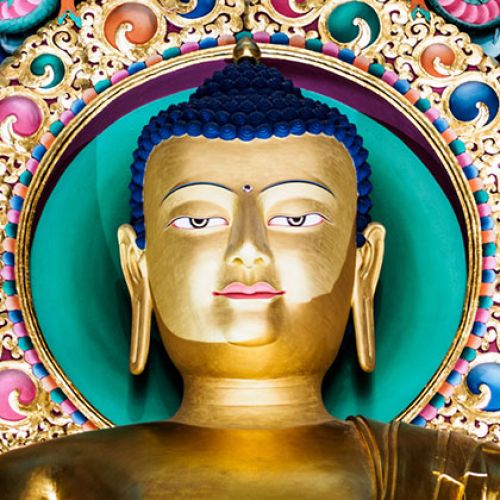
1. Diet
Knowledge of one's personal body constitution is key to selecting the right diet, which is essential for maintaining bodily balance. In terms of diet, we mainly consider two aspects: quantity and quality.
Traditional Tibetan medicine, known as Sowa Rigpa, which translates to 'the science of healing' and 'the support of consciousness,' represents an ancient Eastern healing system. This approach views the human body as a whole and works with the body on physical, energetic, and mental levels.
Alongside traditional Chinese medicine and Ayurveda, Tibetan medicine is one of the three main streams of Eastern healing traditions. It encompasses extensive knowledge in anatomy, physiology, pathology, and offers effective diagnostic and therapeutic methods.
In terms of physical health, Tibetan medicine includes a wide range of natural therapies, including herbal treatments, Kunye massage, balneotherapy, acupuncture, and lifestyle and dietary recommendations.Spiritual practice and understanding the complex system of philosophy, cosmology, and subtle anatomy also play a significant role in the healing process, highlighting the holistic nature of Tibetan medicine. This medicine thus offers a comprehensive approach to achieving and maintaining physical, mental, and spiritual health.
In traditional Tibetan medicine, the concept of health is perceived as a complex state of balance between the body, energy, and mind. Speech plays a key role in this system, representing energy and acting as a bridge connecting the body and mind. According to Tibetan medicine, our body is the product of the interaction of five elements: space, wind, fire, water, and earth. These elements are the foundation of all existence, and their proper balance is essential for maintaining health.
Space, the mother of all elements, is not material in nature—it is an emptiness full of unlimited potential. Without the presence of space, nothing can exist. It is present both in the inner universe (body and mind) and the outer universe (macrocosm).
Wind (vibration) represents movement. It manifests as growth and development. Wind develops our breath and creates our skin—it is also evident in the sense of touch.
Fire (speed) represents heat. It manifests as maturation—our body needs fire for its maturation. The heat of fire is found in the complexion, eyes, and gaze.
Water represents the principle of fluidity, cohesion, and connection. Thanks to water, our body comes together as a cohesive whole. The element of water is found in the blood, lymphatic system, and at the root of the tongue.
Earth represents solidity. On the physical level, it is expressed through bones and tendons, forming the structure of our body.
From these five elements are derived the so-called three life energies, which are the basis of traditional Tibetan medicine—lung (wind), tripa (bile), and beken (phlegm). Their nature is neutral, hot, and cold. Diseases of the body and mind result from the imbalance of these three energies. On the mental level, they are associated with the emotions of desire (lung), anger (tripa), and ignorance (beken).




Tibetan medicine describes that diseases develop when the delicate balance of the three energies is disrupted. The imbalance is caused by the influence of internal psychological factors, which are disturbing emotions, also known as the poisons of the mind—desire/attachment, anger, and ignorance.
In Tibetan medicine, these are called primary causes because they create the conditions for illness (psychosomatics). Secondary causes, or external factors, include improper diet, lifestyle (behavior), the influence of negative energies, and climate.
The four basic treatment methods in traditional Tibetan medicine are diet, healthy lifestyle, medicine, and external therapies.

Knowledge of one's personal body constitution is key to selecting the right diet, which is essential for maintaining bodily balance. In terms of diet, we mainly consider two aspects: quantity and quality.

A healthy lifestyle according to Tibetan medicine includes not only regular exercise but also finding the right balance in all parts of the day and all aspects of life (waking, sleeping, eating, exercising, sex, work, rest). It is recommended to find time for meditation, breathing exercises, or yoga, which reduce physical and mental stress, the cause of many illnesses.

The Tibetan pharmacopeia contains a wide range of medicinal preparations from herbs. In addition to plant substances, mineral substances and, in rare cases, animal substances are also used. Most medicinal substances come from Asia, occasionally from Europe. Depending on their use, medicines can take the form of tablets, powders, decoctions, extracts, creams, or ointments. Their common denominator is their multi-component nature, ranging from ten substances in simple preparations to seventy components in more complex ones. The composition is chosen based on the taste and properties of the substances and helps restore the balance between the three energies. Their effectiveness is also confirmed by current scientific research.

Traditional Tibetan medicine offers a variety of external therapies, each of which can be used alone or in combination with others:
Cupping
Copper cups relieve pain, release stagnant energy, and re-harmonize its flow throughout the body.
Moxibustion
Specific points on the body are heated according to the health problem. There are up to twenty types of moxibustion.
Massage
Kunye massage is an excellent therapy used to maintain or restore the balance of the three energies. It relieves tension and toxins in the body caused by stress.
Acupuncture
Stimulation of precisely defined active points on the surface of the body using special needles. The Tibetan art of acupuncture differs from the well-known Chinese medicine practice and was forgotten for many years. Thanks to the work and research of Dr. Nida Chenagtsang, we are now rediscovering its power.
In Tibetan healing, there are many other therapies used, such as herbal balneotherapy, bloodletting, compresses, stick therapy, and Mongolian moxibustion using warm oil and herbs.
Prevention of Diseases
A proper diet and healthy lifestyle are fundamental to disease prevention. Tibetan medicine believes that most contemporary chronic diseases are the result of mental disorders, improper diet, and poor lifestyle choices. Common examples include diabetes or cardiovascular diseases.
Treatment of Diseases
An imbalance of energy in the body manifests on the physical level as illness. To restore the balance between energies, it is necessary to identify the causes of the disease and choose the appropriate treatment method.
Diagnosis of Diseases
Tibetan medicine utilizes three basic diagnostic methods.
Observation
Here, the doctor assesses the form and composition of the patient's body, skin, and sensory organs. Special emphasis is placed on the character and appearance of the tongue and urine.
Palpation
Examining the pulse and sensitive areas is a very important diagnostic method used in most Eastern medical traditions. However, the method of pulse analysis in Tibetan medicine is entirely different from other systems.
Interview
Precisely targeted questions about the patient's sleep, diet, and overall lifestyle help the doctor diagnose the patient's condition and recommend appropriate therapy.